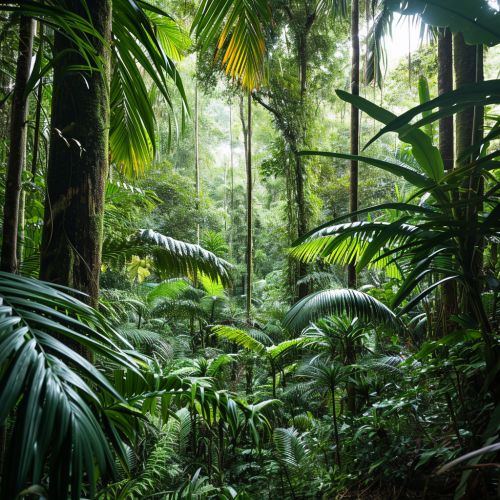Rainforest
Introduction
The Rainforest is a type of forest characterized by high rainfall, with annual rainfall typically exceeding 2000 mm. Rainforests are home to two-thirds of all the living animal and plant species on the planet. It has been estimated that many hundreds of millions of new species of plants, insects, and microorganisms are still undiscovered.
Classification
Rainforests are typically classified into two major types based on their location and climate: Tropical Rainforest and Temperate Rainforest.


Tropical Rainforests
Tropical rainforests are characterized by their location near the equator. This equatorial positioning means that tropical rainforests experience high levels of rainfall and consistently warm temperatures throughout the year. They are the most biodiverse ecosystems on Earth, hosting a vast array of species, many of which are endemic to these habitats.
Temperate Rainforests
Temperate rainforests, on the other hand, are located further from the equator, in coastal areas with cool to warm climates. They receive high amounts of rainfall and are dominated by broadleaf and coniferous trees. While not as biodiverse as their tropical counterparts, temperate rainforests are still rich in species and play a crucial role in global carbon sequestration.
Flora and Fauna
The flora and fauna of rainforests are incredibly diverse, with a high degree of endemism. The species composition and the physical structure of the forest vary greatly depending on the specific conditions of each location.
Flora
The flora of a rainforest is arranged in several vertical layers including the overstory, understory, shrub layer, and forest floor. Each layer has unique characteristics based on the availability of sunlight, moisture, and the adaptation of the species.
Fauna
Rainforests are teeming with an immense variety of fauna, from large mammals and birds to innumerable insects and microorganisms. The fauna, much like the flora, is distributed in various vertical layers, each with its unique ecosystem.
Ecological Importance
Rainforests play a vital role in maintaining the planet's overall health and wellbeing. They are often referred to as the "lungs of the Earth" due to their ability to absorb vast amounts of carbon dioxide and release oxygen through photosynthesis.
Threats and Conservation
Despite their immense ecological importance, rainforests around the world are under severe threat due to human activities. Deforestation, driven by logging, agriculture, and urbanization, is the most significant threat to these ecosystems. Conservation efforts are crucial to protect these vital habitats and the biodiversity they harbor.
